The 1884 Maxim Machine Gun changed the course of warfare and shaped WWI. Its inventor was Hiram Maxim, an American-born Britain, who was an inventor of several devices up until this point. Maxim reportedly came up with the concept of a machine gun when he felt the recoil of a rifle. His design pioneered the first recoil-operated firing mechanism.
The first Maxim machine gun was introduced in 1883 and was used by the British Army in several campaigns. It fired at a rate of 600 rounds per minute (RPM). It was fed by 250 round cloth belts. The caliber was 7.92x57mm. Overall, the gun was comprised of 235 individual parts.
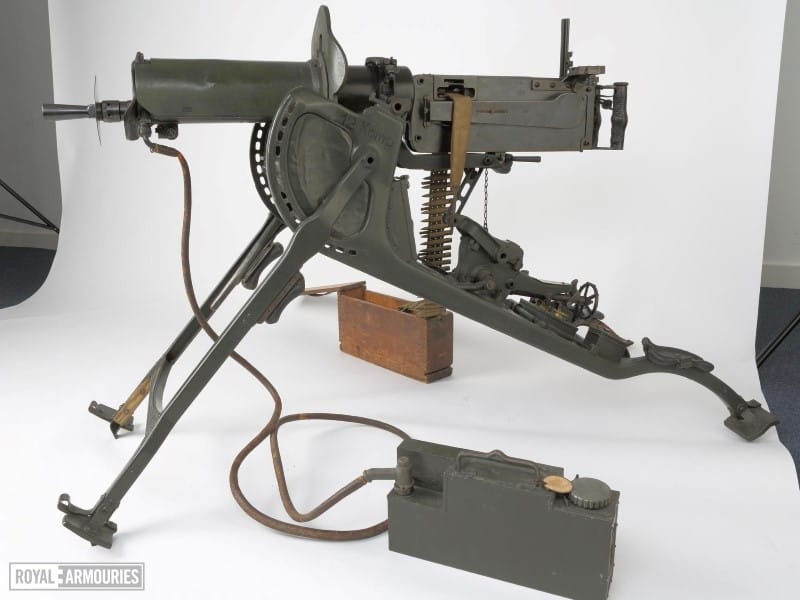
The Maxim utilized a metal water jacket around the barrel, which kept the barrel from overheating. The water tank held 1.057 gallons of water (four liters), which was enough to cool the gun for 2,000 – 2,500 shots. One factor of the MG-08 was that, when the water heated up, it caused steam to rise, especially in the winter, which easily gave away the position of the gun.
We still see this concept in use today, in which the recoil from one cartridge operates the action, ejecting one cartridge and chambering the next one.
Adopted by Germany
Germany was paying attention and apparently saw the potential in this new weapons platform. In 1889, the German rifle commission began firing tests of the Maxim gun at Zorndorf, Germany. Initially, the machine gun was considered to be artillery. However, in 1898, the German light infantry began trials of the gun. At first, the guns were mounted on horse-drawn carriages. The German Navy also made use of the MG08 on ships.
Their Maschinengewehr 08 (named for the year it was adopted, 1908) was Germany’s first heavy machine gun. Similar to the Maxim, the MG08 made use of a water-cooled jacket for the barrel.
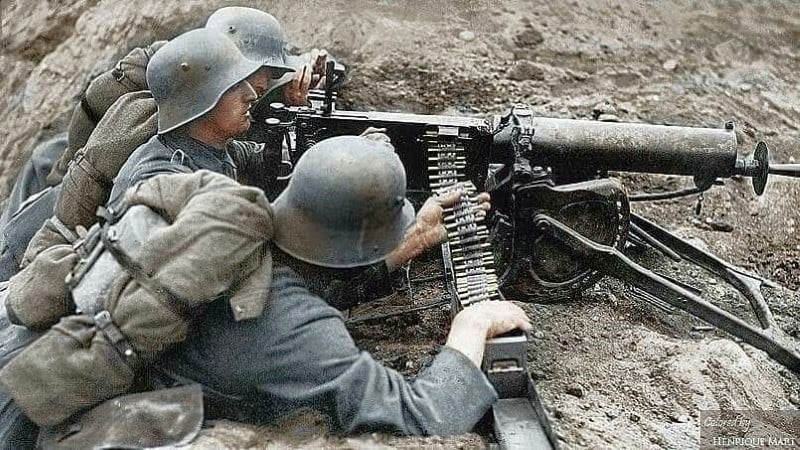
The MG08 machine gun itself weighed approximately 60 pounds. Combined with its “Sled” (or Sledge) mount that used four legs, the whole affair weighed around 140 pounds, excluding the water can and ammunition supply. Along with the sled mount were extra barrels, tools, and oil containers, all attached to the sled. A team of four soldiers was required to move the entire gun and accessories.

The sled folded up into a flat unit that resembled a stretcher, which could be carried by two soldiers. The other two carried the water can and ammunition boxes. A four-man crew was standard for the MG08.
The MG08 was produced in Berlin and also in Spandau. In fact, the machine gun became known by the nickname, “Spandau.”
When WWI broke out in August 1914, Germany had some 12,000 MG08 machine guns available, having been producing about 200 units per month. Germany quickly realized how important the machine gun was in the war, and increased production dramatically. By 1916, they were producing 3,000 per month. By 1917, that number increased to 14,400 per month.
The maximum effective range was considered to be 2,000 yards, although the maximum range was approximately 4,000 yards. At the maximum range, accuracy was not good.
The barrel length of the MG08 was 28 inches. Muzzle velocity is listed at 2,953 feet per second.
It’s interesting to note that over two-thirds of Germany’s small arms ammunition expended during WWI was fired through their machine guns.
Stagnation — Trench Warfare
The MG08’s rate of fire was between 500-600 rounds per minute. Heavy machine guns caused the stalemate of trench warfare in which neither side could advance successfully because charges were nearly guaranteed to be suicidal. Both sides settled into static trench warfare. This is not to say that advances were not made at times, but that they were incredibly costly in terms of lives.

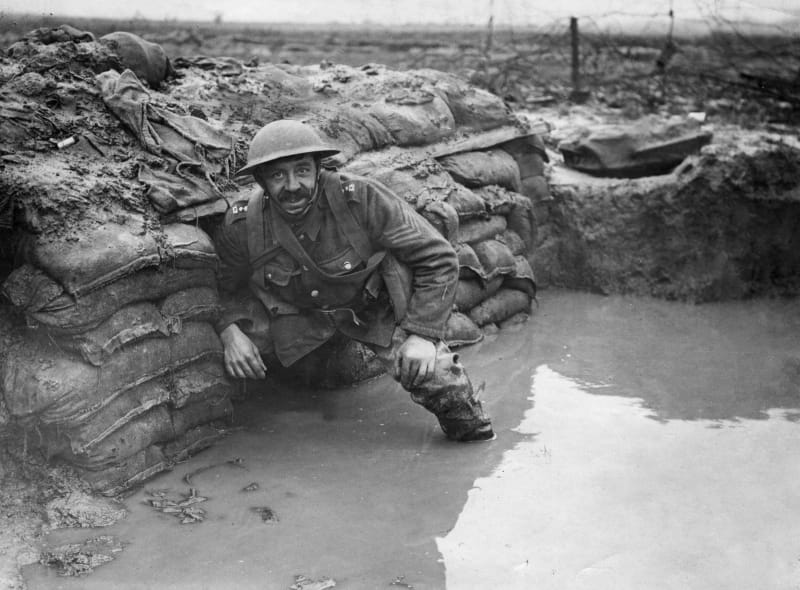
During this stagnation, artillery became another deadly foe for the soldiers in the trenches.
Advances
Not satisfied with merely having the heavy machine gun rest as a defensive weapon, the Germans endeavored to make it more mobile. They adopted more mobile tripods that allowed the gun to be carried forward so that troops could advance with it more readily. One soldier carried the gun while the other carried the tripod.
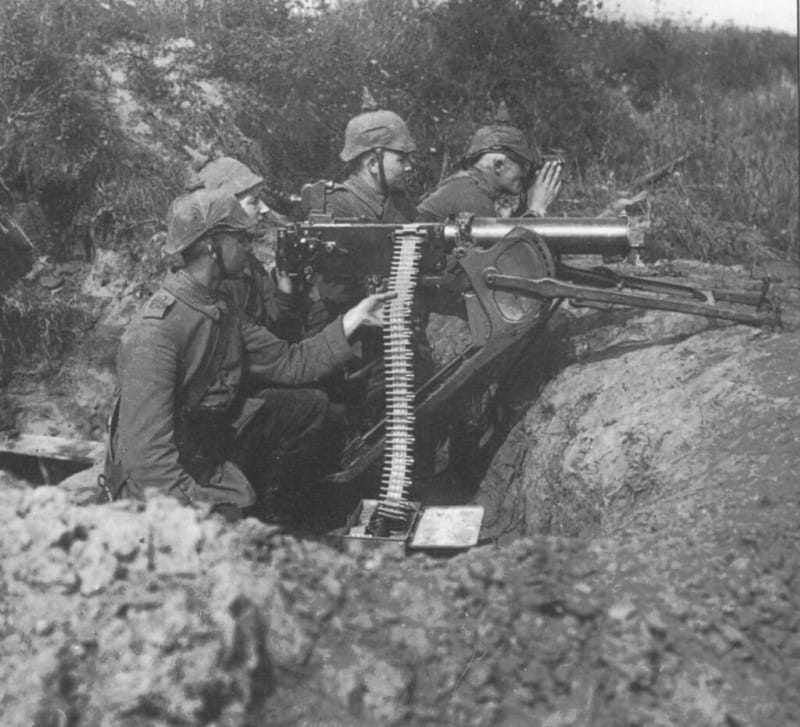
The drawback was that the soldiers had to stop to set up the gun while in No-Man’s Land, which could become hazardous to their health.
A new version was developed called the MG08/15, in which a pistol grip was exchanged for the spade grips. A bipod and rifle-type buttstock were added. Although it could still be fired using ammunition belts, a drum magazine could be affixed to the side. All of these changes lightened the weapon, increasing its mobility. In this configuration, the MG08/15 could be served by a crew as small as two men, who could readily advance with the weapon.
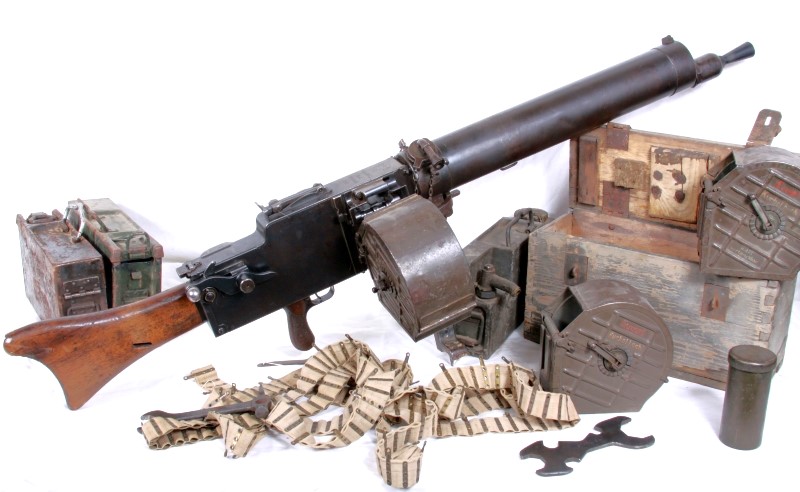
The MG08/15 could be fired as the gunner advanced on foot toward the enemy, while the bipod was employed mostly for defensive use. That being said, the MG08/15 still weighed 40 pounds, so it was a cumbersome piece to lug around during an assault, in addition to the ammunition supply. It was still water-cooled. When the cloth ammunition belts became wet, they would often stretch and develop extraction problems in the gun.
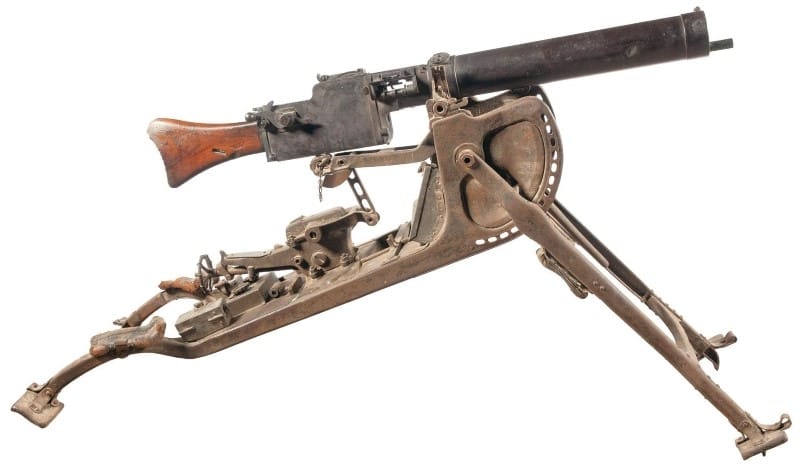
Near the end of the war, an air-cooled version with a heavier barrel was issued. The heavier barrel was to combat overheating, and it was also a changeable barrel. The barrel turned out to be overly complicated to change in the field, however. These air-cooled models were also used on aircraft, first in single mounts, then in doubles. It was also mounted on the aircraft cowling and synchronized to fire through the propeller.
The changeable barrel did eventually go on to be adopted in the MG-34 and MG-42 model machine guns in later years. Especially on the MG-42, the barrel changes could be done extremely quickly and efficiently (in true German fashion). But that’s for a different war.
Summary
By the war’s end, the MG08/15 was the most commonly used machine gun in the German inventory. Six guns per company were issued, which equated to 72 weapons per regiment. All told, over 130,000 units had been produced.

Between WWI and WWII, at least 17 countries bought the machinegun, including Belgium, Yugoslavia, and the Netherlands. Other countries copied it, including the US, Britain, China, and Russia.
Germany did use it in WWII, despite its advanced age, to defend the Atlantic Wall, mostly.
The influence of the Maxim in military history cannot be understated, as it was instrumental in changing how at least one war was fought.


